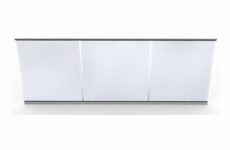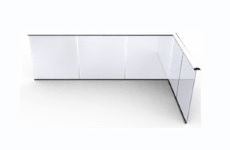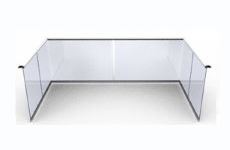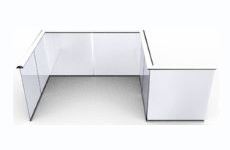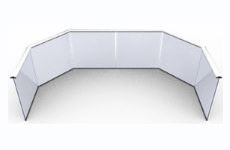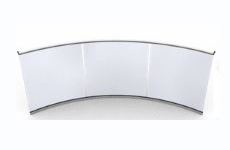Installing glass railings
Glass Balustrades | Juliet Balconies | Galleries | Articles | Case Studies
To price your balustrade requirement first choose the shape most similar to yours
Glass railings look beautiful and add beauty to your home, project or design. You can quite easily design and install your own glass railings at relatively low cost.
Safety Glass Types
In a glass railing safety glass must always be used. This type of glass is defined as glass the breaks safely, and/or "contains" safely. Tempered or toughened glass is very common in the UK whereas laminated glass is more common in Europe.
Toughened glass is approximately four times stronger to impact than regular float glass and is both strong and flexible. But once it breaks it will shatter into many small pieces, theses small pieces are considered safe as they are not dangerous like long shards of glass. Laminated glass, having thinner plates and sometimes not being toughened, will break more easily. What makes laminated glass into safety glass is the plastic interlayer film. The film is either PVB, EVA, SGP or a resin and this film is bonded between the glasses to hold them together and not let any element through.
Testing of laminated glasses can allow the glass to break under impact but stipulates that the glass must not allow penetration of the impacting object, whereas toughened glass must NOT break under impact to satisfy. For example on your car the side windows are usually made from toughened glass but the front windshield is made from laminated glass.
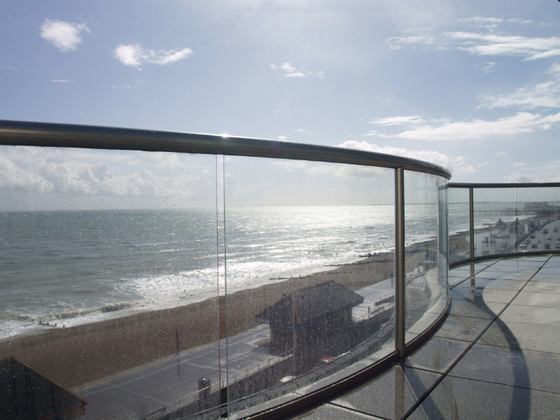
Handling Glass
Storing and transportation of Glass: The transportation of glass and glass railings require some care. If care is not taken while transporting, all that you get at the end of the job is shattered or damaged glass with possibility of injury if handled carelessly. Take the following precautions while transporting and handling the glass items such as glass railings and glass sheets:
- When loose, the glass should never be transported horizontal. The glass plates and sheets should always be put in vertical position.
- The glass should be packed nicely so that it can withstand the transportation. Special packing material is available in market for this purpose.
- The bumps shall be minimized while transporting glass railings. The speed of vehicle should be reduced to minimize or avoid the damage.
- On toughened glass protect the edges in particular. The glass is very strong to frontal impact but its weak point is on the corners and edges
Glass Colours and Types
Most common place is the use of clear glass panels, but because in the manufacture of these in float form iron element is used these have a slight "greenish" tint to them. The thicker the glass the more it is noticeable.
Therefore when 15mm, 19mm glass or when 21.5mm or 17.5mm laminated is used in glass railings some are put off by this greenish tint. There is a product called "Low-Iron" glass with various trade names in the market such a "diamant" by Saint Gobain or "Optiwhite" by Pilkington. These are super clear and do not have the green tint of regular clear float glass. These are rather more expensive but available all the same.
If however you prefer tinted glass for glass railings, there are Green, Bronze, Grey and Blue tinted float glass available. These are usually in 10mm thickness but are available up to 12mm thick. All thicker glass types - 15mm, 19mm, 24mm are available in clear only.
A new type of glass is becoming available and in particular seems the way forward in glass balustrades and glass railings is "self-cleaning" glass. This is glass that will have rain or water keep it cleaner without the build-up of dust and dirt on the glass. Self-Cleaning glass divides into two types. There is a biochemical type and a hydrophobic coating based on nano-technology silicone films. The former is said to last the lifetime of the glass and is only on one face of the glass and the latter can be applied to both faces but needs reapplication after 5-10 years. The use of these is growing in the balustrade market due to the functionality issues with cleaning glass on the outside of a glass rail.
Here at Balcony Systems Solutions Ltd we have developed our own unique hydrophobic coating that we apply to many of our products called BalcoNano®. To find out more about BalcoNano® visit the website www.BalcoNano.com
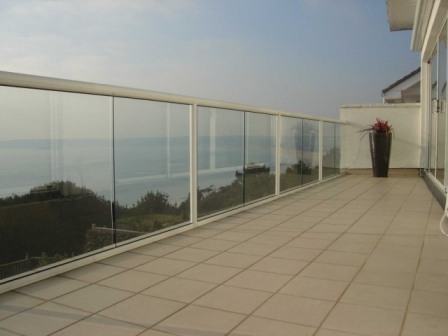
Safety While Handling Glass Railings
Your safety is as important as the safety of the glass railings, in fact more important. So while handling glass or glass railings make sure that you wear hand gloves. It is also important to use sufficient number of persons so each one handles the load they can safely carry. In case this is not done and the load carried by one person is transferred to other person quickly, it has a domino effect and the glass item being handled will get broken at the same time the shards of glass can injure many persons at the same time.
Safety While Fixing Glass Railing In Position
The fixing of glass railing is a delicate affair. Any mistake while fixing glass or the top railing will damage it. Specialised materials have been developed so that the glass becomes fixed in its place and there is no possibility of shifting the glass once it is fixed in position. Rubber grommets, rubber shoes, EPDM gaskets etc. and beading around the glass are used and are very effective.
Types of Glass Railings
Glass railings may be just the top balustrade, or complete sheets of glass used instead of any other metallic supports, or figurines in various forms on the staircase with the top railing made of glass. The imagination of the designer is the only restraint. The glass railings, like glass Patio railings can take many forms and in each form, it adds to the beauty of the space, it covers.
Aftercare of Glass Railings
The glass requires relatively little aftercare; just wiping the dust is sufficient in most cases, in particular if a protective glass coating has been used. Toughened glass is used in most glasswork for public place. The life of glass is almost infinite and it is not affected by most acids and alkalis. The only acid that can affect glass is hydrofluoric acid. Since this acid is not in common use, the only care you might have to take is avoiding the company of boisterous children bent on breaking glass items.
